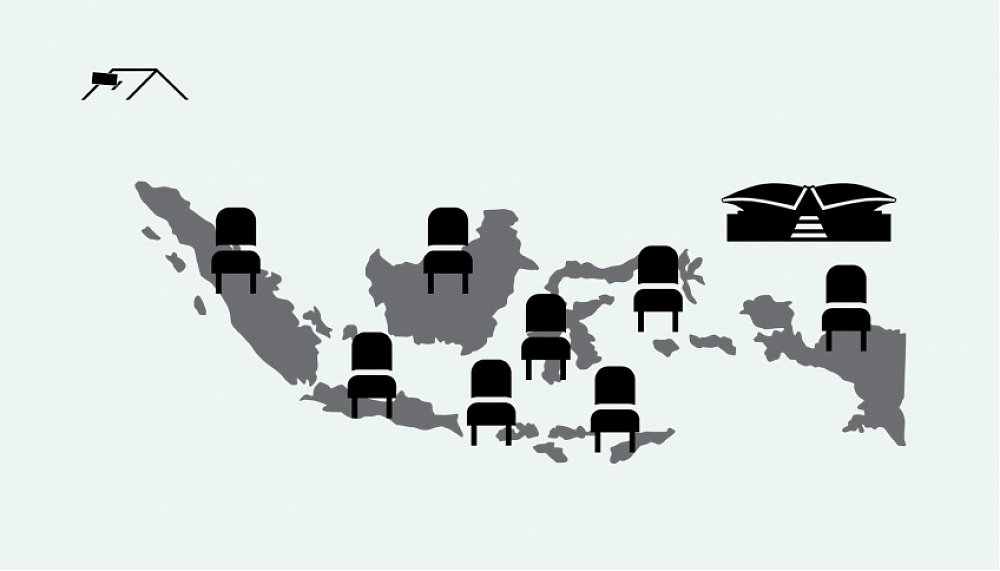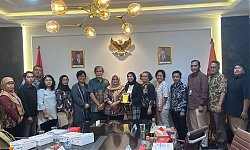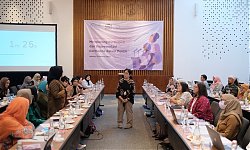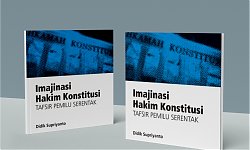If the Constitutional Court issues a decision changing the open proportional electoral system to a closed one, then the 2024 election will change radically compared to the previous three national elections. The election results will change the number of political parties and the party system in the DPR.
Indonesia had previously implemented a closed proportional electoral system in two election periods. The 1955 and 1999 elections. These two national election periods, in terms of contestation, were the best elections in the history of Indonesian elections.
Why do we only need to consider 1955 and 1999 in an overview of the electoral system? In fact, we know, during the New Order, a closed proportional election system was also implemented? The answer is, because the Soeharto Era Election was an election that lied to us (the Javanese call it, "push"). So, the sentence "as old as my age anyway?" From the advertisement for Soeharto's Smile, we must argue with the conclusion that it was the time to fake elections.
Let us not compare the electoral conceptual with a government that has made its citizens hate politics. The New Order and its Golkar have destroyed the organization of political parties and their ideology. If any of us are still afraid of party oligarchy as an effect of the implementation of a closed proportional electoral system, then that is part of our trauma from the success of the New Order indoctrination.
DPR political parties are reduced
If the 2024 Election uses closed proportional, then the number of DPR political parties will decrease. If we refer to the average of the various electability survey results, there are only seven parties that can exceed the 4% parliamentary threshold to enter the DPR. This electability average comes from 5 Survey Institutions (End of 2022): Charta Politika (12), SMRC (12), Indicators (12), Indonesian Survey Institute (8), Poltracking (11).
The seven parties in the 2024 DPR are the Indonesian Democratic Party of Struggle (PDIP), the Great Indonesia Movement Party (Gerindra), the Golongan Karya Party (Golkar), the Democratic Party, the National Awakening Party (PKB), the Prosperous Justice Party (PKS), and the Democratic National Party ( Nas-Dem). The electability of each of these parties is PDIP 24.4%, Gerindra 10.9%, Golkar 10.2%, Democrats 8.8%, PKB 7.4%, PKS 6.1%, and Nas-Dem 4.1%.
If the electability of these parties is converted based on 580 DPR seats, then each party will proportionally get DPR seats with the following distribution: PDIP 197 seats, Gerindra 88, Golkar 82, Democrat 71, PKB 60, PKS 49, and Nasdem 33.
Table 1. 2024 DPR Seat Calculation and Comparison with 2019 DPR Seats
|
NO |
DPR Parties |
%The Voters of |
%DPR |
DPR Total |
DPR Total Seats 2019 |
Seat Difference |
|
1 |
PDIP |
24.4 |
33.9 |
197 |
128 |
69 |
|
2 |
Gerindra |
10.9 |
15.2 |
88 |
78 |
10 |
|
3 |
Golkar |
10.2 |
14.2 |
82 |
85 |
-3 |
|
4 |
Demokrat |
8.8 |
12.2 |
71 |
50 |
21 |
|
5 |
PKB |
7.4 |
10.3 |
60 |
59 |
1 |
|
6 |
PKS |
6.1 |
8.5 |
49 |
54 |
-5 |
|
7 |
Nasdem |
4.1 |
5.7 |
33 |
58 |
-25 |
|
8 |
PPP |
(3.1) |
- |
0 |
19 |
-19 |
|
9 |
PAN |
(2.4) |
- |
0 |
44 |
-44 |
|
JUMLAH |
71.9 |
100 |
580 |
575 |
5 |
|
|
Remaining Vote Percentage |
28.1 |
|
|
|
|
|
From these calculations, we can find out which parties gain or lose from the implementation of a closed proportional system. The PDI-P, with 128 seats in the DPR from the 2019 elections, has benefited the most from 197 seats from the 2024 elections, or an additional 69 seats. The one that suffered the most was PAN with 44 seats from the 2019 election results, becoming seatless from the 2024 election because it did not pass the parliamentary threshold of 4% (2.4%). In the same fate as PAN, PPP, which has an electability of 3.1%, must lose all seats in the DPR in the 2019 election results.
It is possible that these calculations became one of the reasons why PDIP submitted a judicial review of changes to the electoral system from open to closed through the Constitutional Court. After PDIP, the political party that has benefited proportionally from being closed is the Democrats. As a political party that is relatively interpreted as an opposition party, the 50 seats in the 2019 election results have become 71 seats in the 2024 election, or an additional 21 seats.
Nas-Dem became the second political party that suffered the most in closed proportions. It could be that this is in the context of the lack of influence in the nomination of Anies Baswedan as a presidential candidate. Nas-Dem lost 25 seats out of 58 seats in the 2019 election results, becoming 33 seats in the 2024 election results.
Moderate multiparty
From the composition of these seats, we can get the number of the DPR's 2024 party system. The calculation of this party system is based on the effective number of parliamentary parties (ENPP) formula. The results of the calculation will be grouped according to the number. ENPP number 1 means that it belongs to the single party system group. If ENPP has a number of 2, it means that there are two strong and relatively balanced parties in parliament, so this belongs to the two-party system group that is usually modeled on the Democrat-Republicans in the United States. If the ENPP score is more than 2, it means that there are more than two strong and relatively balanced parties in parliament, so this is included in the multiparty party system group which is usually modeled on the party system in the Dutch and German parliaments.
The multiparty party system was then divided into two. First, moderate multiparty with an ENPP score of 3 to 5. Second, extreme multiparty with an ENPP score of more than 5.
The ENPP figure is not the same as the number of political parties on the ballot and in parliament. Ballots can accommodate far more political parties. Then, the number of political parties entering parliament can be far greater than the ENPP figure.
For example, in the 1999 election, political parties participating in the election on ballot papers totaled 48. Then there were 21 political parties that entered the DPR. However, the ENPP score of 21 parliamentary political parties was only 4.7 so that they were included in the moderate multiparty party system group.
Since Indonesia implemented a semi-open proportional system in the 2004 DPR election with an electoral district size of 3-12 seats, the DPR has produced an extreme multi-party party system (7.1). Then in the 2009, 2014 and 2019 DPR elections with an open proportional system and a 3-10 seat electoral district, it still produced extreme multi-party (6.1, 8.2 and 7.5).
A closed proportional system will end Indonesia's extreme multiparty trend to become a moderate multiparty. The ENPP value is likely to be in the range of 5. We can prove this by simulating using party electability data for the 2024 election.
Table 2. Calculation of ENPP Simulation of 2024 Election Results
|
NO |
DPR Party 2024 |
%The Voice of Electability |
%DPR Seats |
DPR Total Seats |
ENPP |
|
|
1 |
PDIP |
24.4 |
33.9 |
197 |
0.3 |
0.12 |
|
2 |
Gerindra |
10.9 |
15.2 |
88 |
0.2 |
0.02 |
|
3 |
Golkar |
10.2 |
14.2 |
82 |
0.1 |
0.02 |
|
4 |
Demokrat |
8.8 |
12.2 |
71 |
0.1 |
0.01 |
|
5 |
PKB |
7.4 |
10.3 |
60 |
0.1 |
0.01 |
|
6 |
PKS |
6.1 |
8.5 |
49 |
0.1 |
0.01 |
|
7 |
Nasdem |
4.1 |
5.7 |
33 |
0.1 |
0.00 |
|
JUMLAH |
71.9 |
100 |
580 |
|
0.19 |
|
|
|
28.1 |
|
|
5.1 |
||
The ENPP score of 5.1 means that the 2024 election with a closed proportional system has succeeded in creating a moderate multiparty party system. The value of this moderate party system is the desired result of a country adhering to a multiparty system. Moreover, Indonesia also implements a presidential system of government which tends to create a split government. Extreme multiparty presidency becomes a systemic state that makes all its adherent countries underperform and corrupt.
Avoiding extreme multi-party formation in parliament does not guarantee that a country will be better off in democracy. However, there is no country that has a good democracy and can be prosperous, implementing an extreme multi-party party system. If we refer to a number of indices of countries in democracy/freedom (Freedom House) and clean from corruption (Transparency International), we can conclude that the ranking of countries between indices is relatively similar. If we relate it to the political system, we get the findings that there is no country whose government is running well, has an extreme multi-party party system.
That is part of the reason, the loss of opposition in the DPR. Extreme multiparty has consequences for the fluidity of party ideology in the DPR because many parties have a relatively even percentage of seats. This situation makes the DPR political party work based on the objective of obtaining a power share and development projects from the head of government as a consequence of legislation.
The simulation results in this paper are likely to be similar to the actual 2024 election results. So far, the electability survey results of political parties are very different from the percentage of votes acquired in the election results officially determined by the General Elections Commission. The basic reason is because political party electability survey questions are irrelevant to the electoral system that is implemented, especially the 2009, 2014 and 2019 elections.
The electability survey questions for political parties are more or less as follows: "Ladies and gentlemen, if today were voting day, which political party would you vote for?" This question is only relevant in closed proportional electoral systems.
In fact, in 2009, 2014 and 2019, the DPR election used an open proportional system. Voters can directly vote for each legislator candidate's name. Indeed, the inconsistency of the open proportional system in Indonesia allows voters to choose the name/symbol of a political party, but the number of voters is small.
The discrepancy between electability survey questions and the application of the electoral system, so an explanation of why, the results of the legislative election survey are relatively inaccurate. It is predictable that PKS, PAN, Nas-Dem, and even PPP will not pass the parliamentary threshold to enter the DPR.
In fact, the list of candidates compiled by all parties can influence the acquisition of more votes so that the results are far different from the electability survey results. On the voting ballot "D-Day" of voting, far more voters chose the name of the candidate directly, not the name/symbol of a political party. The reasons could be quality, identity, kinship, popularity, beauty/handsomeness, money politics, or a combination of these considerations.
So, from the closed proportional simulation of the 2024 DPR Election, will we receive the actual process and results later? []
USEP HASAN SADIKIN











